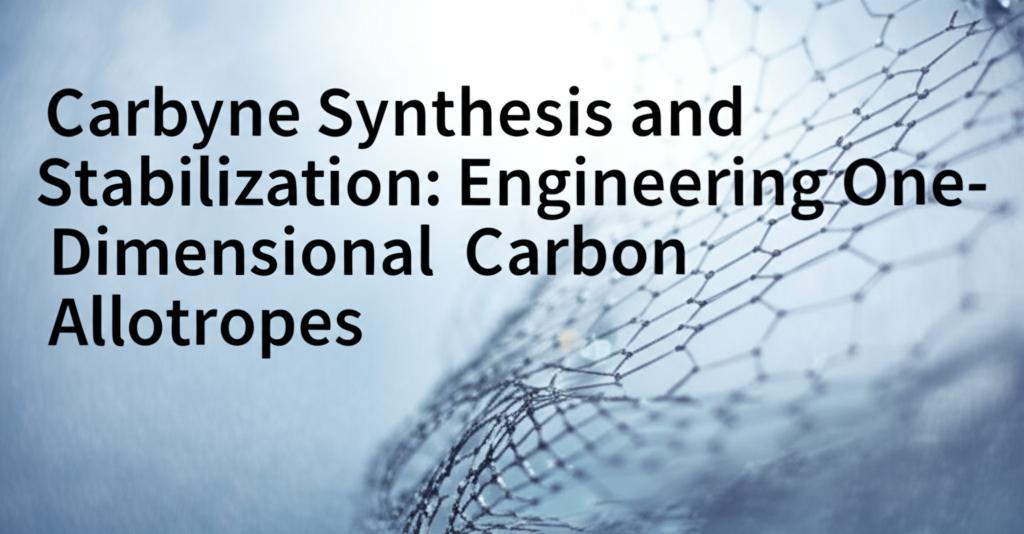Carbyne, a truly one-dimensional chain of carbon atoms, continues to be a subject of intense research due to its extraordinary predicted properties. It is theorized to be stronger and stiffer than any other known material, including diamond and graphene. Its unique electronic characteristics, which can vary with the length of the carbon chain, make it a promising candidate for next-generation nanoelectronics, optoelectronics, and spintronic devices.
However, the synthesis and stabilization of carbyne have proven to be significant hurdles. Carbyne is highly reactive and prone to instability under ambient conditions, often bending, coupling, or reacting with neighboring chains to form more stable sp2-hybridized carbon structures like graphene or fullerenes.
Recent Breakthroughs in Synthesis and Stabilization:A major advancement in overcoming carbyne's instability involves its encapsulation within carbon nanotubes (CNTs). This method acts as a protective sheath, preventing the carbyne chains from interacting and degrading.
- Low-Temperature Synthesis in Single-Walled Carbon Nanotubes (SWCNTs): Recently, an international research team, including scientists from Penn State, has developed a method to synthesize carbyne within SWCNTs at low temperatures. This is a significant step, as previous high-temperature methods were often unsuitable for SWCNTs, which can lose stability at elevated temperatures. The new approach utilizes a gentle starting material, ammonium cholate, to grow carbyne at much lower temperatures. Encapsulating carbyne in SWCNTs offers better protection than thicker, multi-walled nanotubes (MWCNTs) used in the past, as SWCNTs cause minimal disturbance to the carbyne chain, interacting only through weak van der Waals forces. This method also boasts higher yields and lower costs, opening doors for more extensive research and potential real-world applications. This "weakly confined carbyne" (wCC) more closely resembles free-standing carbyne, allowing for better study of its intrinsic properties.
- Enhanced Yield with Liquid Precursors: Another breakthrough involves using liquid precursors encapsulated within double-walled carbon nanotubes (DWCNTs). This technique has significantly enhanced the yield of confined carbyne.
- Stepwise Growth and Isotope Labeling: Researchers have also explored the stepwise growth of confined carbyne, where SWCNTs are first transformed into DWCNTs. Furthermore, this method allows for isotope labeling of the carbyne chains by using isotopically labeled liquid precursors (e.g., 13C-methanol). This capability provides unprecedented control to tune the physical properties of carbyne and offers a pathway to engineer its functionality.
- On-Surface Synthesis: On-surface synthesis is another promising avenue. This technique involves the dehydrogenative coupling of molecules like ethyne with metal atoms (e.g., copper) on a metallic surface (e.g., Cu(110)) under ultrahigh vacuum conditions. This method has successfully produced metalated carbyne chains extending into the submicron scale (up to ~120 nm). Another on-surface strategy involves the demetallization of organometallic polyynes on surfaces like Au(111) to form long and stable polyynic carbon chains. Researchers have even achieved the synthesis of an atomically precise C14 polyyne via tip-induced dehalogenation and ring-opening of precursor molecules on a NaCl/Au(111) surface.
- Hydrothermal Synthesis from Agro-Industrial Waste: A novel approach has demonstrated the synthesis of carbyne nanocrystals from graphene nanoconstrictions using a simple hydrothermal technique with agro-industrial waste (molasses) as the carbon source. This method produces carbyne nanocrystals on few-layer holey graphene, exhibiting interesting paramagnetic and electrochemical properties, including high sensitivity for detecting toxic metals like As3+ in groundwater.
Despite these advancements, several challenges remain:
- Bulk Synthesis: While confinement in CNTs and on-surface synthesis have produced longer and more stable carbyne chains than ever before (some exceeding 6,000 carbon atoms within DWCNTs), achieving true bulk synthesis of free-standing carbyne remains a significant hurdle.
- Characterization: Characterizing these one-dimensional structures can be complex. While techniques like transmission electron microscopy (TEM) and Raman spectroscopy are commonly used, others like UV-Vis spectroscopy can be hindered by overlapping absorption from the surrounding CNTs. Tip-enhanced Raman scattering (TERS) imaging is emerging as a powerful tool to access detailed vibrational features and even thermodynamic properties of carbyne chains.
- Understanding Fundamental Properties: Continued research is crucial to fully understand the fundamental mechanical, thermal, and electronic properties of carbyne, especially how these properties vary with chain length, end groups, and confinement effects. Theoretical models predict exceptional properties, but experimental verification is ongoing. For instance, carbyne's electrical properties can make it a natural semiconductor, unlike graphene which requires engineering to introduce a bandgap. This makes carbyne particularly attractive for transistor applications.
The remarkable predicted properties of carbyne pave the way for numerous potential applications:
- Nanoelectronics and Optoelectronics: Carbyne's tunable electronic properties and ability to conduct electricity make it a candidate for ultra-thin molecular wires, transistors, and components in nanoelectronic and optoelectronic devices, potentially leading to faster and more efficient electronics than current silicon-based technology. Its potential as a light emitter is also of great interest.
- Spintronics: Carbyne may find uses in quantum spin transport and magnetic semiconductors.
- High-Strength Composites: Its predicted superior strength and stiffness could lead to the development of ultra-strong, lightweight composite materials.
- Sensors: The sensitivity of carbyne's properties to its environment and its unique Raman scattering cross-section suggest applications as tracers or contact-free temperature sensors. The demonstrated use of carbyne nanocrystals for detecting toxic metals showcases its sensing potential.
- Energy Storage: The unique structure of carbyne suggests a very high theoretical capacity for applications like Li-ion storage.
The field of carbyne synthesis and stabilization is rapidly evolving. Recent breakthroughs, particularly in confined synthesis within carbon nanotubes and on-surface fabrication, have brought this elusive one-dimensional carbon allotrope closer to practical application. While challenges in bulk production and full characterization persist, the ongoing research continues to unveil new synthesis pathways and deepen our understanding of carbyne's extraordinary properties. The future looks bright for carbyne, with the potential to trigger significant developments in materials science, nanoelectronics, and beyond.

